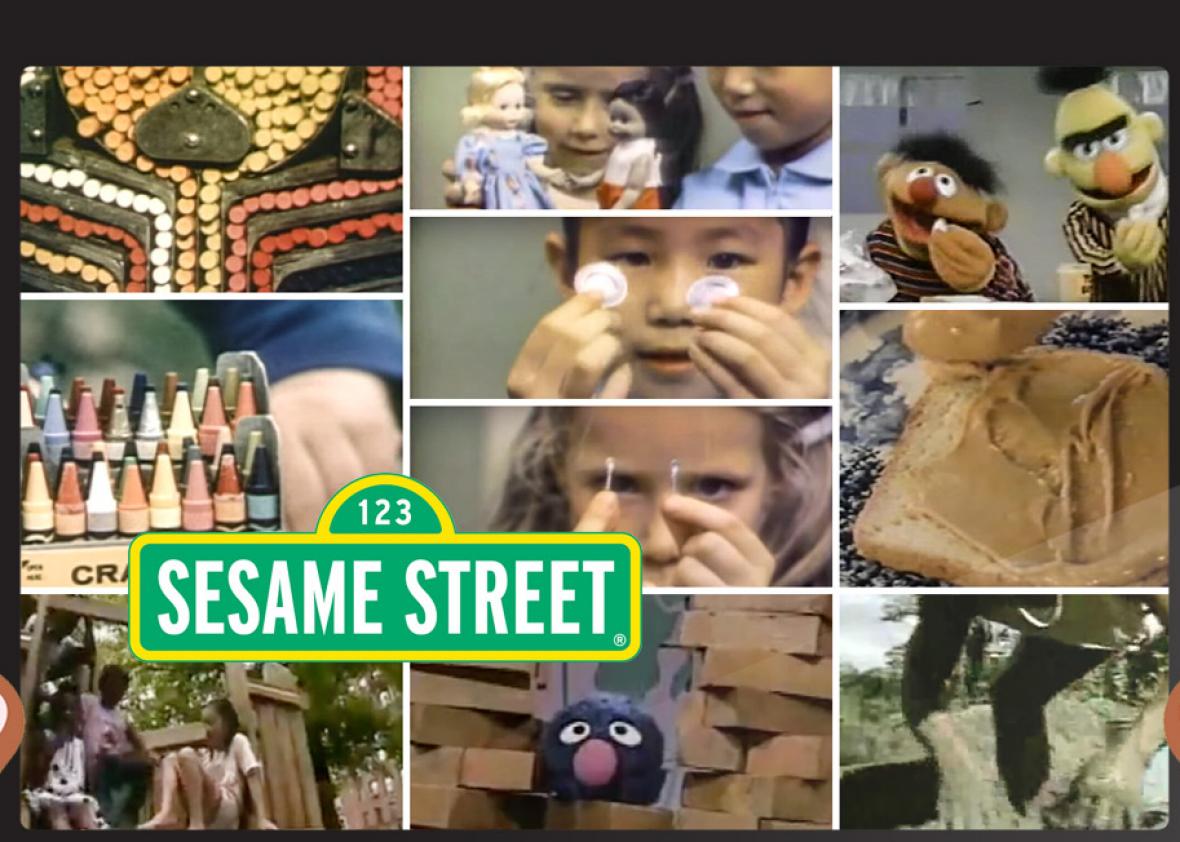Screen Time is Slate’s pop-up blog about children’s TV, everywhere kids see it.
If I were famous and dead, an ingenious, semi-psychic biographer could convincingly argue that Sesame Street was the cipher to my entire life. It’s the reason I live in New York City and do the work that I do. It has influenced what I read and eat and wear; it’s responsible for what I think is funny and interesting and worth attending to and also to blame, possibly, for my most nontrivial foibles: my short attention span, my inability to organize thoughts into narrative, my financially crippling aversion to postwar architecture. No cultural product has had a bigger impact on who I am.
Sesame Street often gets conflated in the adult imagination with the burlesque Muppets whose primary-color images have been printed in picture books for decades. But the bits I most remember are the baroque animations and micro-documentaries about real children, often from immigrant families or remote corners of the country, that appeared in between the episodes’ so-called plot. The amount that I’ve retained from these interstitial elements of the show is staggering, especially considering how otherwise terrible my memory is. How do I know how coconuts get harvested? How mail is delivered in rural Appalachia? That zydeco is accordion- and washboard-based? I know from visiting Sesame Street.
It’s in these parts of the show that Sesame Street reveals the way it understands, better than anything that’s ever been on television, a child’s obsession with invisible and procedural labor, whether it’s the construction of an urban playground, the machinations of a crayon factory, the process by which bricks are made by hand in Nicaragua, or how a whole jar of peanut butter comes from one tiny legume.
The spirit is retained, somewhat, in contemporary episodes of Sesame Street, though the commercial break–like shorts are now, like the titular block itself, gentrified: new, bright, thematically linked. I never watch them. Instead, almost every week, I play clips of vintage Sesame Street on YouTube when I should be working. It’s an odd, developmentally inappropriate method of procrastination and self-soothing, but it’s cheaper than therapy. And the promises are the same: the thrill of insight and the satisfaction of having my inner life reverse-engineered.
One of my favorite clips features two little girls playing with a dollhouse. The putative purpose of the video is to teach binary counting. Each child has her own doll and they spend the length of the video performing matching activities: setting the table (“One, two, two little plates…”), getting them ready for bed (“One, two, two sleepyheads”), and so on. There’s giggling, a delightful third-act domestic disturbance, and one of the prettiest melodies ever recorded.
The video is 90 seconds long, and—like so many others from Sesame Street that I remember fondly—holds within it the germs of many small but privately important-to-me opinions: that the lives and minds of children are more interesting than those of teenagers; that much of the best art takes diversity as a matter of course rather than a point of polemic; that working within an institution can be a noble route to self-actualization; that watching an ordinary person go about her day is a valid and ethical way to spend one’s time.
In 1972, about three years after Sesame Street premiered on PBS, Renata Adler, then working at the New Yorker, wrote nearly 4,000 hilariously imperious words about it. She made astute observations— like the fact that the show is “extremely patient with error and frustration”—and praised its devotion to “odd, useful intelligence.” Her chief insight, though, was that the actual substance of Sesame Street aspires to be, and often is, art. That this was apparent to a television critic in the earliest years of the show’s production is a testament to its quality. Now it seems obvious—especially to someone who, like me, watched hundreds of hours of Sesame Street as a child and now traces almost all of her personal taste and aesthetic sensitivities to it.
The show is credited, rightly, for its innovative pedagogy and progressive ethics, but children who are raised on it are taught more than the alphabet. They’re taught—or at least I was taught—to have high expectations: from education, from entertainment, from the adults who provided both. Sesame Street is animated by a kind of secular Pascal’s Wager. Who knows what goes through small children’s minds, especially while they’re zoned out in front of the TV. Maybe very little. But why not assume a lot? Why not take them seriously, treat them as sophisticated consumers, and operate as though they’re worthy of genuinely beautiful and thoughtful things?
